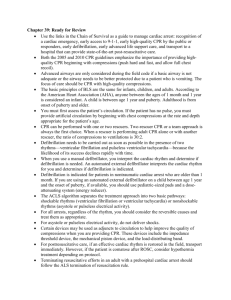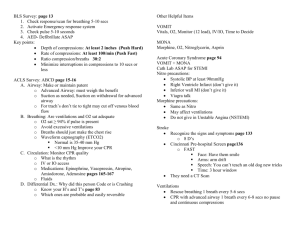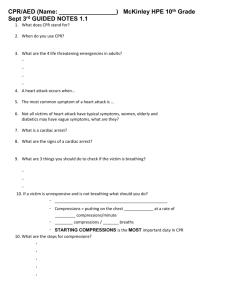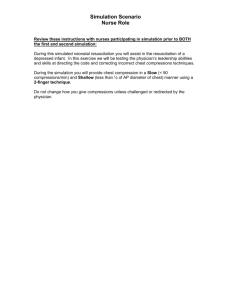Ventricular Fibrillation Pulseless Ventricular Tachycardia
advertisement
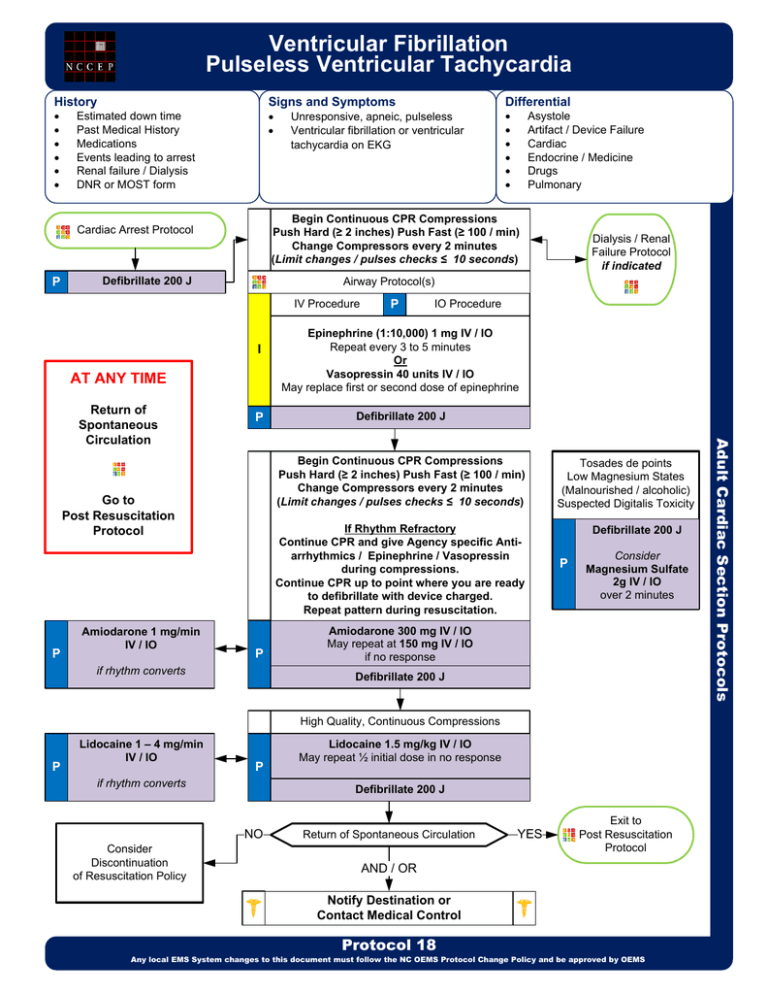
Ventricular Fibrillation Pulseless Ventricular Tachycardia History · · · · · · · · Unresponsive, apneic, pulseless Ventricular fibrillation or ventricular tachycardia on EKG Defibrillate 200 J I AT ANY TIME P Dialysis / Renal Failure Protocol if indicated IO Procedure Epinephrine (1:10,000) 1 mg IV / IO Repeat every 3 to 5 minutes Or Vasopressin 40 units IV / IO May replace first or second dose of epinephrine Defibrillate 200 J If Rhythm Refractory Continue CPR and give Agency specific Antiarrhythmics / Epinephrine / Vasopressin during compressions. Continue CPR up to point where you are ready to defibrillate with device charged. Repeat pattern during resuscitation. P if rhythm converts Tosades de points Low Magnesium States (Malnourished / alcoholic) Suspected Digitalis Toxicity Defibrillate 200 J P Consider Magnesium Sulfate 2g IV / IO over 2 minutes Amiodarone 300 mg IV / IO May repeat at 150 mg IV / IO if no response Defibrillate 200 J High Quality, Continuous Compressions P Lidocaine 1 – 4 mg/min IV / IO P if rhythm converts Defibrillate 200 J NO Consider Discontinuation of Resuscitation Policy Lidocaine 1.5 mg/kg IV / IO May repeat ½ initial dose in no response Return of Spontaneous Circulation YES Exit to Post Resuscitation Protocol AND / OR Notify Destination or Contact Medical Control Protocol 18 Any local EMS System changes to this document must follow the NC OEMS Protocol Change Policy and be approved by OEMS Adult Cardiac Section Protocols P P Begin Continuous CPR Compressions Push Hard (≥ 2 inches) Push Fast (≥ 100 / min) Change Compressors every 2 minutes (Limit changes / pulses checks ≤ 10 seconds) Go to Post Resuscitation Protocol Amiodarone 1 mg/min IV / IO Asystole Artifact / Device Failure Cardiac Endocrine / Medicine Drugs Pulmonary Airway Protocol(s) IV Procedure Return of Spontaneous Circulation · · · · · · Begin Continuous CPR Compressions Push Hard (≥ 2 inches) Push Fast (≥ 100 / min) Change Compressors every 2 minutes (Limit changes / pulses checks ≤ 10 seconds) Cardiac Arrest Protocol P Differential Signs and Symptoms Estimated down time Past Medical History Medications Events leading to arrest Renal failure / Dialysis DNR or MOST form Ventricular Fibrillation Pulseless Ventricular Tachycardia Adult Cardiac Section Protocols Pearls · · · · · · · · · · · · · · Recommended Exam: Mental Status Efforts should be directed at high quality and continuous compressions with limited interruptions and early defibrillation when indicated. Consider early IO placement if available and difficult IV anticipated. DO NOT HYPERVENTILATE: If no advanced airway (BIAD, ETT) compressions to ventilations are 30:2. If advanced airway in place ventilate 8 – 10 breaths per minute with continuous, uninterrupted compressions. Do not interrupt compressions to place endotracheal tube. Consider BIAD first to limit interruptions. Breathing / Airway management after second shock and / or 2 rounds of compressions (2 minutes each round.) Avoid Procainamide in CHF or prolonged QT. Effective CPR and prompt defibrillation are the keys to successful resuscitation. If no IV / IO, drugs that can be given down ET tube should have dose doubled and then flushed with 5 ml of Normal Saline followed by 5 quick ventilations. IV / IO is the preferred route when available. Reassess and document endotracheal tube placement and EtCO2 frequently, after every move, and at transfer of care. Do not stop CPR to check for placement of ET tube or to give medications. If BVM is ventilating the patient successfully, intubation should be deferred until rhythm has changed or 4 or 5 defibrillation sequences have been completed. Return of spontaneous circulation: Heart rate should be > 60 when initiating anti-arrhythmic infusions. Sodium bicarbonate no longer recommended. Consider in the dialysis / renal patient, known hyperkalemia or tricyclic overdose at 50 mEq total IV / IO. Follow manufacture's recommendations concerning defibrillation / cardioversion energy when specified. Protocol 18 Any local EMS System changes to this document must follow the NC OEMS Protocol Change Policy and be approved by OEMS
